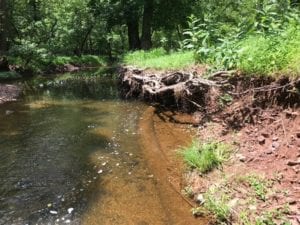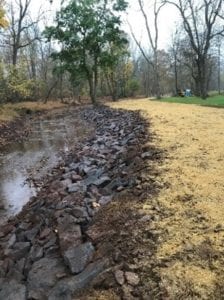The force of water against banks can cause erosion by dislodging soil particles. If a pipeline crosses a stream with eroding banks, the line is susceptible to exposure and damage if the erosion issue is not addressed.

What is LPSTP?
A common method of bank stabilization is longitudinal peaked stone toe protection (LPSTP), which was developed by the United States Army Corps of Engineers (USACE). This technique works well with existing vegetation on the upper bank that is in danger of being undermined and washed away by a migrating stream. This method is encouraged by the USACE and the U.S. Fish and Wildlife (USFWS) service due to the natural stream appearance and the creation of a riparian habitat.
How to Install LPSTP
Rock or crushed concrete is mounded at the toe of the slope, where the bank erosion process usually begins. The toe is kept firm by the mass of rock, and the upper bank above the rock vegetates and becomes stable by the root systems holding the upper bank area.
The upper bank will be either shaped behind the mound of rock or allowed to seek a natural angle of repose over time, and vegetation will occur by natural stream processes. Tie-backs or keys are cut into the bank and filled with rock to prevent water from flowing behind the LPSTP.
The keys help to stabilize the bank, provide a recharge of rock if other rock is dislodged, and prevent flanking of the LPSTP if the stream begins to migrate.


